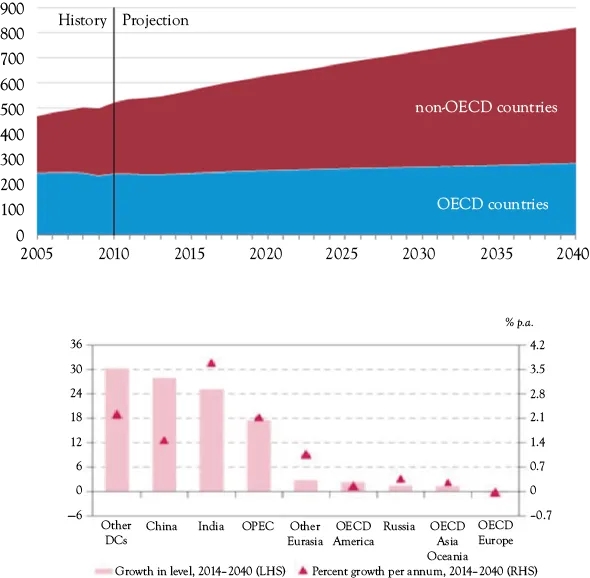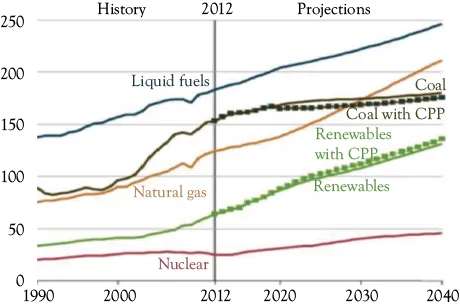![]()
PART I
Prospects for Energy,
Commodities, Water, Food,
and Healthcare
![]()
CHAPTER 1
Energy, Commodities, and Water
- The Surge of Energy Demand in Developing Economies
- Rising and Falling Energy Resources
- The Attractiveness of Natural Gas
- The Rise of Alternative and Renewable Energies in Developed and Developing Economies
- Growing Demand for Natural Resources
- International Trade of Natural Resources
- Higher Levels of Price Volatility
- Global Perils of Water Scarcity
The Surge of Energy Demand in Developing Economies
The global primary energy demand has grown 1.6 times since 1970, from 104.5 million barrels of oil equivalent (mboe/d) in 1970 to 273.9 mboe/d in 2014 and is expected to increase by another 40 percent by 2040 [8]. The most important driver of energy demand is economic growth, which is often measured in terms of the gross domestic product (GDP). The world’s GDP is expected to rise by 3.3 percent per year between 2012 and 2040, suggesting a steady increase in energy demand over the course of the next three decades. The fastest rates of economic growth belong to the developing economies outside of the Organization for Economic Cooperation and Development (OECD) with a GDP growth of almost 4.2 percent per year. In the developed economies or the OECD club, the GDP will grow at a much slower rate of 2 percent per year over the course of the next three decades [1]. Energy consumption per capita in the OECD region has already peaked around 2005 and is now either stable or declining. This pattern of energy consumption in developed economies relates to service-based and technologically advanced economies that capitalize on energy-efficiency gains [8]. The developed and rich economies still have the highest levels of energy consumption per capita, but they are marked by more mature economies and lower levels of population growth. It is estimated that the per capita energy use in the OECD countries is still 60 to 70 percent higher than that in the rest of the world. For example, in the United States, energy consumption is almost 30 times higher than in Bangladesh.
Because of a combination of higher population growth, economic development, and changes in their lifestyles, the developing economies will experience the highest levels of increase in energy consumption in the next three decades. Across the world, more than 1.3 billion people still do not have access to electricity, and 3 billion people use simple stoves burning waste, wood, and animal dung for heating and cooking [2]. As the least developed regions of the world undergo socio-economic development, they will necessarily add to the global energy consumption [3]. In emerging and developing economies, energy consumption per capita is poised to increase over the course of the next three decades, reflecting greater electrification, urbanization, expansion of the middle class, and strong economic growth[8]. According to the International Energy Agency (IEA), non-OECD energy demand will increase by over 70 percent between 2012 and 2040 compared with a growth of 18 percent in OECD nations [4] (see Figure 1.1). By 2020, China will surpass OECD America in terms of real GDP, and by 2040, China’s GDP will be more than 1.5 times that of OECD America. Similarly, India will surpass the OECD Europe around 2034, and by 2040, India’s real GDP will be about the same size as the OECD America [8]. The two Asian giants China and India will lead the developing world in rising standards of living, GDP growth, and an increase in energy demand. China and India together will account for almost half the expected increase in global energy demand by 2040 [5, 1]. In addition, a group of 10 countries consisting of Brazil, Mexico, South Africa, Nigeria, Egypt, Turkey, Saudi Arabia, Iran, Thailand, and Indonesia collectively will account for about 30 percent of the projected growth in energy demand in the next three decades [5]. According to the U.S. Energy Information Administration, two-thirds of the world’s primary energy will be consumed in the developing economies by 2040. This level of energy consumption in developing economies represents an increase of 54 percent from 2010’s levels. By contrast, the OCED countries, including European nations, the United States, Canada, Japan, and Australia, will experience an increase of almost 0.5 percent a year in energy demand [6]. The global growth in energy demand is driven mainly by road transportation, petrochemicals, and aviation sectors. As the developing economies are significantly lagging behind the developed economies in the number of cars per capita, they represent a huge potential for growth in the size of the global car fleet that will clearly boost the global energy demand [7]. The total number of passenger cars is expected to double in only 25 years between 2015 and 2040, reaching from 1 billion to 2.1 billion [2]. Similarly, aviation demand growth is expected to accelerate in every region of the world, but mostly in China and India. An important remark is that many developing economies lack the required infrastructure or resources to utilize and improve energy resources efficiently and often rely on carbon-polluting coal and other fossil fuels to generate electricity. Consequently, the world’s levels of greenhouse gas emissions and other pollutants are expected to rise significantly. Unless the developing economies like China and India switch to alternative and clean energies, we can expect disastrous environmental consequences.
Figure 1.1 Projected world primary energy consumption until 2040
source: [2].
Rising and Falling Energy Resources
According to the IEA, the total investment in the energy sector is estimated at around 1.8 trillion U.S. dollars per year [2]. Consistent with the same estimates, a cumulative 44 trillion U.S. dollars in investment is needed in global energy supply by 2040. While almost all types of energy resources are expected to grow, renewables are believed to be the fastest-growing energy sources over the course of the next three decades (see Figure 1.2). According to the International Energy Outlook (IEO), renewable energy consumption will grow by an average of 2.6 percent per year between 2017 and 2040 [1]. After renewable energies, nuclear power is the world’s second fastest-growing energy source (see Figure 1.2). Despite some serious security concerns, the consumption of nuclear energy is predicted to increase by 2.3 percent per year in the next three decades [1]. The consumption of fossil fuels has been subject to extensive criticism in the past decade, and for that reason, this source of energy may have a much slower growth rate than previously expected. Between 2014 and 2015, the fossil fuel consumption subsidies dropped from 500 billion U.S. dollars to 325 billion U.S. dollars, reflecting a significant decline in the fossil fuel development [2]. Regulations to accelerate fuel efficiency improvements and a faster penetration of alternative fuel vehicles may significantly reduce fossil fuel demand. Nevertheless, fossil fuels are expected to constitute 78 percent of the energy mix in 2040 [1]. According to the OPEC, oil and natural gas together will account for almost 53 percent of the energy needs in 2040, which is equal to the present levels [8]. Much of the demand for oil comes from the transport sector. Substitution of oil in the transport sector is happening, but it is not expected to reach more than 5 percent for the next decade [9]. Currently, several fundamental changes are affecting the oil industry, including the emergence of non-OPEC oil supply, the rise of shale oil, heavy oil, and tar sands, and increased production from mature and frontier fields [9]. According to the IEO2016 reports, the consumption of oil and other liquid fuels is expected to grow from 90 million barrels per day in 2012 to 121 million barrels per day in 2040. Traditionally, the transportation and industrial sectors are the main consumers of oil and other liquid fuels. Oil will probably remain the fuel with the largest share at least for the next two decades and eventually will be overtaken by gas around 2040 or afterward [8].
Figure 1.2 Total world energy consumption by energy source 1990–2040 (Quadrillion Btu)
source: [1].
Note: Dotted lines for coal and renewables show projected effects of the U.S. Clean Power Plan.
Among the fossil fuels, natural gas is the fastest-growing source of energy in the next four decades, as its consumption is supposed to increase by 1.9 percent per year [1]. Due to its adverse environmental effects, coal is recognized as the world’s slowest-growing energy source. According to the IEO2016 projections, the consumption of coal is expected to grow only 0.6 percent per year by 2040. While its share in the total global energy mix is expected to decline, the overall coal consumption is expected to increase in the long term [8]. Currently, more than 7,700 million tons of coal is used by many sectors, including power generation, iron and steel production, cement manufacturing, and as a liquid fuel. It is th...


